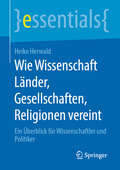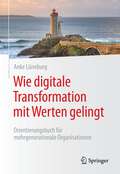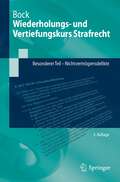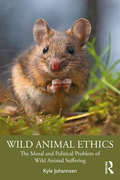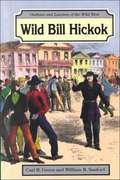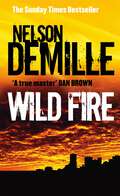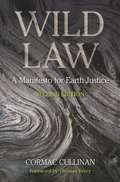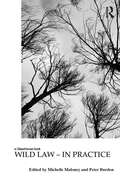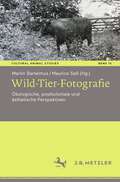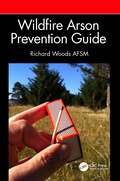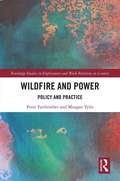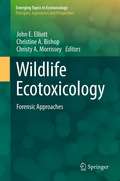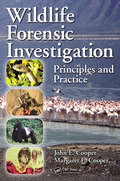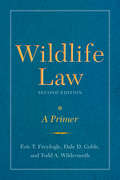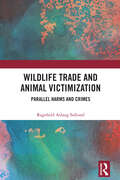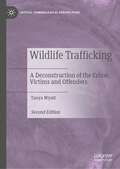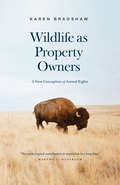- Table View
- List View
Wie Wissenschaft Länder, Gesellschaften, Religionen vereint: Ein Überblick für Wissenschaftler und Politiker (essentials)
by Heiko HerwaldUnsere heutige Welt ist geprägt von einer rasanten technologischen Entwicklung. Die daraus resultierende digitale Reizüberflutung, das unermessliche Sammeln von Daten und die Entwicklung von Algorithmen, die für uns jetzt schon Entscheidungen übernehmen, haben das Wertesystem der Menschen verändert. Anhand des Höhlengleichnisses von Platon beschreibt der Autor, wieso der Mensch seine Unabhängigkeit aufgibt und er sich von einem Homo sapiens zu einem Homo accumulans (speichernder Mensch) entwickelt hat. Er zeigt auf, warum Paradigmenwechsel in Religion, Politik und Wissenschaft für die Weiterentwicklung der Menschheit von großer Bedeutung waren und wieso dies für die Wissenschaft auch weiterhin notwendig sein wird, um Lösungen für globale Probleme zu entwickeln.
Wie digitale Transformation mit Werten gelingt: Orientierungsbuch für mehrgenerationale Organisationen
by Anke LüneburgWerte sind Leuchttürme der digitalen und der kulturellen Transformation. Das Buch zur digitalen Transformation durch Werte zeigt, dass die digitale Transformation und das erfolgreiche Recruiting von Talenten nur dann erfolgreich umgesetzt werden können, wenn Führungskräfte in Unternehmen und Verwaltungen Klarheit über ihre eigenen biografischen Werte und deren Wurzeln gewinnen. Nur so können sie ihren Teams die nötige psychologische Sicherheit bieten.Praxisbezogen zeigt es Ihnen Ursachen und Hindernisse, durch die Organisationen und Führungskräfte bei großen Herausforderungen wie der digitalen Transformation und dem Fachkräftemangel ausgebremst werden.Es erklärt die üblichen Fallstricke und hilft Ihnen zu erkennen, warum neue Konzepte und Veränderungen nicht in die Praxis umgesetzt werden oder Mitarbeiter der Generationen Y und Z nur kurz im Unternehmen bleiben. Durch die aufgezeigten Lösungswege zur notwendigen Veränderungsdurchführung erhalten Sie eine klare Orientierung, die Ihnen hilft, die genannten Hindernisse zu beseitigen. Dazu erfahren Sie, wie durch eine Passung persönlicher und unternehmerischer Werte ein erfolgreiches Change-Management, HR-Management und Führungskonzept aufgebaut werden kann.Zielgruppen: Alle diejeningen, die den digitalen Wandel zeitnah umsetzen und ihr Unternehmen bzw. ihre Organisation auf der Basis passender Werte verbessern wollen, d.h. Führungskräfte aller Ebenen, Unternehmensleitungen, HR-Abteilungen, Organisations- und Personalentwickler:innen, Unternehmensberater:innen, Coaches, Trainer:innen und Mediator:innen Zur Autorin: Anke Lüneburg ist professionell ausgebildete Leadership Coach, Master-Coach DGfC, Mediatorin BM® sowie Beraterin und war 25 Jahre Führungskraft in Wirtschaftsbetrieben und öffentlichen Organisationen. Als Sparringspartnerin begleitet sie Organisationen und Führungskräfte, die eine kulturelle oder digitale Transformation umsetzen wollen und ist Lehrbeauftragte im Bereich Wirtschaftspsychologie. Seit 2018 ist sie Autorin bei Springer mit den Themen Leadership, Führung, Generationen, Arbeit 4.0 und Persönlichkeitsentwicklung und schreibt mit ebenso großer Freude Blogtexte und Artikel.
Wie und warum zitieren Gerichte?: Intertextuelle Bezugnahmen in den Entscheidungen des Bundesverfassungsgerichts und des Supreme Court of Canada (Literatur und Recht #12)
by Joy Steigler-HermsGerichtsentscheidungen können ohne Bezugnahmen auf andere Texte weder getroffen noch verfasst werden, Zitate sind in Gerichtsentscheidungen omnipräsent. Jede Entscheidung berücksichtigt einschlägige Normtexte oder Präjudizien, in erster Linie zur Sicherstellung einer kohärenten Rechtsprechung. Durch den Akt des Bezugnehmens demonstrieren Gerichte, dass sie in ihren Entscheidungen auf einer etablierten Rechtsdogmatik aufbauen. Diese Integration in die bestehende Dogmatik legitimiert die Entscheidung und schafft damit Rechtssicherheit durch Rechtsvorhersagbarkeit. In Gerichtsentscheidungen finden sich darüber hinaus Bezugnahmen auf Texte, die nicht über rechtliche Autorität verfügen und denen entsprechend keine derartige Funktion zugeschrieben werden kann. Unter den von Gerichten zitierten Quellen finden sich neben Gesetzestexten z.B. auch Bezüge auf ausländisches Recht, auf wissenschaftliche Quellen oder sogar auf literarische Texte. Die vorliegende Arbeit beschäftigtsich in Anbetracht dessen mit der Frage, wie und warum Gerichte zitieren. Am Beispiel von Entscheidungen des Bundesverfassungsgerichts und des Supreme Court of Canada schlägt die interdisziplinäre Studie sowohl philologische als auch rechtswissenschaftliche Auswertungskriterien zur empirischen Rekonstruktion von Zitatfunktionalisierungen vor und nimmt dabei ferner auch eine komparative Perspektive auf rechtskreisbedingte Unterschiede zwischen den Zitationspraktiken vor Gericht ein.
Wiederholungs- und Vertiefungskurs Strafrecht: Allgemeiner Teil (Springer-Lehrbuch)
by Dennis BockAnhand von 13 „großen Fällen“, die nach aktuellen und klassischen Entscheidungen der höchstrichterlichen Rechtsprechung gebildet sind und nach den Anforderungen im Ersten Juristischen Staatsexamen gelöst werden, vermittelt das Werk sowohl examensrelevantes Wissen im strafrechtlichen Pflichtfachbereich als auch die Falllösungstechnik zur Bewältigung strafrechtlicher Klausuren. Es ermöglicht so eine prüfungsnahe Wiederholung und Vertiefung des materiellen Strafrechts, wobei insbesondere Wert darauf gelegt wird, klausurtypische Querverbindungen von Allgemeinem Teil und Besonderem Teil aufzuzeigen. Die vollständig ausformulierten Lösungsvorschläge werden abgerundet durch klausurtaktische Bemerkungen und didaktisch konzipierte Vertiefungshinweise, insbesondere zur klassischen und aktuellen Rechtsprechung (inkl. wichtiger Entscheidungsbesprechungen). Der Band zum Allgemeinen Teil wird ergänzt durch einen zum „Besonderen Teil - Nichtvermögensdelikte“ und einen zum „Besonderen Teil - Vermögensdelikte“. Die Gesamtreihe befähigt zu einer vollständigen, eigenverantwortlichen Examensvorbereitung im materiellen Strafrecht. Sie erscheint nunmehr in vollständig durchgesehener und überarbeiteter Neuauflage inklusive examensorientierter Verarbeitung jüngster höchstrichterlicher Rechtsprechung sowie Studienliteratur.
Wiederholungs- und Vertiefungskurs Strafrecht: Besonderer Teil - Nichtvermögensdelikte (Springer-Lehrbuch)
by Dennis BockDer Band zu den Nichtvermögensdelikten enthält sieben „große Fälle“, die aktuellen und klassischen Entscheidungen der höchstrichterlichen Rechtsprechung nachgebildet sind und den Anforderungen im Ersten Juristischen Staatsexamen entsprechen. Auf diese Weise wird sowohl das prüfungsrelevante Wissen im strafrechtlichen Pflichtfachbereich als auch die Falllösung wiederholt und vertieft. Besonderes Augenmerk wird auf klausurtypische Querverbindungen von Allgemeinem und Besonderem Teil gelegt. Die Lösungsvorschläge sind vollständig ausformuliert und werden abgerundet durch Hinweise zur Klausurtaktik und zur Vertiefung des Stoffs etwa anhand grundlegender Gerichtsentscheidungen. Der Band zum Besonderen Teil - Nichtvermögensdelikte wird ergänzt durch einen zum „Allgemeinen Teil“ und einen zum „Besonderen Teil - Vermögensdelikte“. Die Gesamtreihe befähigt zu einer vollständigen, eigenverantwortlichen Examensvorbereitung im materiellen Strafrecht. Sie erscheint nunmehr in vollständig durchgesehener und überarbeiteter Neuauflage inklusive examensorientierter Verarbeitung jüngster höchstrichterlicher Rechtsprechung sowie Studienliteratur.
Wiederholungs- und Vertiefungskurs Strafrecht: Besonderer Teil - Vermögensdelikte (Springer-Lehrbuch)
by Dennis BockIm Band zu den Vermögensdelikten sind 13 „große Fälle“ abgedruckt, die sich an aktuellen und klassischen Entscheidungen der höchsten Gerichte orientieren. Entsprechend den Anforderungen im Ersten Juristischen Staatsexamen werden so zum einen das examensrelevante Wissen im strafrechtlichen Pflichtfachbereich als auch die Technik der Falllösung wiederholt und vertieft. Klausurtypische Querverbindungen von Allgemeinem Teil und Besonderem Teil kommen dabei nicht zu kurz. Neben vollständig ausformulierten Lösungsvorschlägen enthält das Werk wertvolle Tipps zur Klausurtaktik und zur Vertiefung des materiellen Strafrechts, insbesondere anhand der Rechtsprechung. Der Band zu den Vermögensdelikten wird ergänzt durch einen zum „Allgemeinen Teil“ und einen zum „Besonderen Teil - Nichtvermögensdelikte“. Die Gesamtreihe befähigt zu einer vollständigen, eigenverantwortlichen Examensvorbereitung im materiellen Strafrecht. Sie erscheint nunmehr in vollständig durchgesehener und überarbeiteter Neuauflage inklusive examensorientierter Verarbeitung jüngster höchstrichterlicher Rechtsprechung sowie Studienliteratur.
Wild Animal Ethics: The Moral and Political Problem of Wild Animal Suffering
by Kyle JohannsenThough many ethicists have the intuition that we should leave nature alone, Kyle Johannsen argues that we have a duty to research safe ways of providing large-scale assistance to wild animals. Using concepts from moral and political philosophy to analyze the issue of wild animal suffering (WAS), Johannsen explores how a collective, institutional obligation to assist wild animals should be understood. He claims that with enough research, genetic editing may one day give us the power to safely intervene without perpetually interfering with wild animals’ liberties. Questions addressed include: In what way is nature valuable and is intervention compatible with that value? Is intervention a requirement of justice? What are the implications of WAS for animal rights advocacy? What types of intervention are promising? Expertly moving the debate about human relations with wild animals beyond its traditional confines, Wild Animal Ethics is essential reading for students and scholars of political philosophy and political theory studying animal ethics, environmental ethics, and environmental philosophy.
Wild Animal Skins in Victorian Britain: Zoos, Collections, Portraits, and Maps
by Ann C. ColleyWhat did the 13th Earl of Derby, his twenty-two-year-old niece, Manchester’s Belle Vue Zoo, and even some ordinary laborers all have in common? All were avid collectors and exhibitors of exotic, and frequently unruly, specimens. In her study of Britain’s craze for natural history collecting, Ann C. Colley makes extensive use of archival materials to examine the challenges, preoccupations, and disordered circumstances that attended the amassing of specimens from faraway places only vaguely known to the British public. As scientific institutions sent collectors to bring back exotic animals and birds for study and classification by anatomists and zoologist, it soon became apparent that collecting skins rather than live animals or birds was a relatively more manageable endeavor. Colley looks at the collecting, exhibiting, and portraying of animal skins to show their importance as trophies of empire and representations of identity. While a zoo might display skins to promote and glorify Britain’s colonial achievements, Colley suggests that the reality of collecting was characterized more by chaos than imperial order. For example, Edward Lear’s commissioned illustrations of the Earl of Derby’s extensive collection challenge the colonial’s or collector’s commanding gaze, while the Victorian public demonstrated a yearning to connect with their own wildness by touching the skins of animals. Colley concludes with a discussion of the metaphorical uses of wild skins by Gerard Manley Hopkins and other writers, exploring the idea of skin as a locus of memory and touch where one’s past can be traced in the same way that nineteenth-century mapmakers charted a landscape. Throughout the book Colley calls upon recent theories about the nature and function of skin and touch to structure her discussion of the Victorian fascination with wild animal skins.
Wild Bill Hickok (Outlaws and Lawmen of the Wild West)
by Carl R. Green William R. SanfordChronicles the life of the Western lawman Wild Bill Hickok.
Wild Bill Hickok and Calamity Jane: Deadwood Legends
by James D. Mclaird(back of book) Although Wild Bill Hickok and Calamity Jane spent only a few weeks in Deadwood at the same time, their fame and fate have become intertwined and their relationship legendary. James D. McLaird examines the contemporary accounts that turned these two Wild West wanderers into dime-novel and motion-picture stars. Contemporary novelists and journalists created an astonishingly strong legacy for both Calamity Jane and Wild Bill, accounting for much of their notoriety. Gunfights, scouting missions, and daring escapes from enemies filled stories about the dashing pair; even their day-to-day existence seems to have been fraught with danger and excitement, teetering on the brink between lawful and unlawful. McLaird traces the role that writers and the city of Deadwood itself played in the creation of the legacies of the infamous couple. Fact and fiction have become so woven together that a definitive picture of Calamity Jane and Wild Bill is almost impossible. Their brief friendship and subsequent burial next to each other in Mount Moriah Cemetery simply added to their legendary status and made them stalwarts of Wild West pop culture and Deadwood mythology. Wild Bill Hickok and Calamity Jane: Deadwood Legends is the second book in the South Dakota Biography Series, which highlights some of the state's most famous residents.
Wild Diplomacy: Cohabiting with Wolves on a New Ontological Map
by MorizotStarting from a specific case, the spontaneous return of wolves to France and the intense conflicts that event has triggered, the French philosopher Baptiste Morizot invites us to think about what he calls "diplomacy with living beings." How can we conceive of cohabitation with the most recalcitrant wildlife, large predators in particular, and what concrete solutions need to be invented to make this happen? Drawing on knowledge gleaned from history and philosophy as well as from ethology, scientific ecology, and biology, Wild Diplomacy prompts us to ask what relations we want to reinvent with living beings today and how we might fundamentally reimagine our status as living beings among other life forms. This prize-winning book has broken new ground in contemporary French environmental philosophy.
Wild Fire: Number 4 in series (John Corey #4)
by Nelson DeMilleWelcome to the Custer Hill Club - an informal men's club set in a luxurious Adirondack hunting lodge whose members include some of America's most powerful business leaders, military men, and government officials. Ostensibly, the club is a place to gather with old friends, hunt, eat, drink, and talk off-the-record about war, life, death, sex and politics. But one Fall weekend, the Executive Board of the Custer Hill Club gathers to talk about the tragedy of 9/11 and what America must do to retaliate. Their plan is finalized and set into motion.That same weekend, a member of the Federal Anti-Terrorist Task Force is reported missing. His body is soon discovered in the woods near the Custer Hill Club's game reserve. The death appears to be a hunting accident, and that's how the local police first report it, but Detective John Corey has his doubts. As he digs deeper, he begins to unravel a plot involving the Custer Hill Club, a top-secret plan known only by its code name: Wild Fire. Racing against the clock, Detective Corey and his wife, FBI agent Kate Mayfield, find they are the only people in a position to stop the button from being pushed and chaos from being unleashed.
Wild Law
by Cormac CullinanCullinan, CEO of an environmental law and policy consultancy in Cape Town, South Africa, presents the second edition of his ambitious 2003 volume outlining his vision of a legal system based on the laws of nature rather than those of an industry-based, man-made society. He begins by demonstrating the current human-centric state of man's relationship with nature, in which we view ourselves as separate, independent, and dominant; continues to posit an alternative view inspired by climate science and indigenous cultures, wherein we are interdependent with and reliant upon the natural world; and proceeds to employ political theory, legal history, science, and contemporary philosophy in service of his theory of Earth Jurisprudence and Earth Governance, which questions everything from property ownership, to the modern concept of time, to the legal rights of trees. Annotation ©2011 Book News, Inc. , Portland, OR (booknews. com)
Wild Law - In Practice (Law, Justice and Ecology #4)
by Peter Burdon Michelle MaloneyWild Law - In Practice aims to facilitate the transition of Earth Jurisprudence from theory into practice. Earth Jurisprudence is an emerging philosophy of law, coined by cultural historian and geologian Thomas Berry. It seeks to analyse the contribution of law in constructing, maintaining and perpetuating anthropocentrism and addresses the ways in which this orientation can be undermined and ultimately eliminated. In place of anthropocentrism, Earth Jurisprudence advocates an interpretation of law based on the ecocentric concept of an Earth community that includes both human and nonhuman entities. Addressing topics that include a critique of the effectiveness of environmental law in protecting the environment, developments in domestic/constitutional law recognising the rights of nature, and the regulation of sustainability, Wild Law - In Practice is the first book to focus specifically on the practical legal implications of Earth Jurisprudence.
Wild-Tier-Fotografie: Ökologische, postkoloniale und ästhetische Perspektiven (Cultural Animal Studies #15)
by Martin Bartelmus Maurice SaßTechnische Innovationen der Fotografie erlaubten Ende des 19. Jahrhunderts, Wildtiere nicht mehr nur als Kadaver und Beute oder in Studio und Gehege abzulichten, sondern ihnen in ihrem natürlichen Habitat nachzuspüren. Die frühe Wildtierfotografie bediente damit ein populäres Interesse an der als lokal, national oder kolonial geschätzten Fauna, lieferte wichtige Beiträge zur zoologischen Forschung und verstand sich häufig als Vorkämpfer des Naturschutzes. Ganz neu stellte sich damit aber auch die Frage, wie man Tiere richtig fotografiert: technisch, ästhetisch, ethisch. Der Band beantwortet diese Fragen in historischer Perspektive und erschließt damit das Forschungsfeld der Wildtierfotografie.
Wilde Lake: A Novel
by Laura LippmanThe New York Times bestselling author of the acclaimed standalones After I'm Gone, I'd Know You Anywhere, and What the Dead Know, challenges our notions of memory, loyalty, responsibility, and justice in this evocative and psychologically complex story about a long-ago death that still haunts a family.Luisa "Lu" Brant is the newly elected--and first female--state's attorney of Howard County, Maryland, a job in which her widower father famously served. Fiercely intelligent and ambitious, she sees an opportunity to make her name by trying a mentally disturbed drifter accused of beating a woman to death in her home. It's not the kind of case that makes headlines, but peaceful Howard county doesn't see many homicides.As Lu prepares for the trial, the case dredges up painful memories, reminding her small but tight-knit family of the night when her brother, AJ, saved his best friend at the cost of another man's life. Only eighteen, AJ was cleared by a grand jury. Now, Lu wonders if the events of 1980 happened as she remembers them. What details might have been withheld from her when she was a child?The more she learns about the case, the more questions arise. What does it mean to be a man or woman of one's times? Why do we ask our heroes of the past to conform to the present's standards? Is that fair? Is it right? Propelled into the past, she discovers that the legal system, the bedrock of her entire life, does not have all the answers. Lu realizes that even if she could learn the whole truth, she probably wouldn't want to.
Wilderness Protection in Europe
by Kees BastmeijerEurope still retains large areas which play host to numerous native and free-functioning ecosystems and lack roads, buildings, bridges, cables and other permanent manifestations of modern society. In the past such areas were considered wastelands, whose value lay only in their potential for cultivation and economic exploitation. Today, these wilderness areas are increasingly cherished as places for rest and recreation and as important areas for scientific research, biodiversity conservation and the mitigation of and adaptation to certain climate change effects. This book provides the first major appraisal of the role of international, European and domestic law in protecting the remaining wilderness areas and their distinguishing qualities in Europe. It also highlights the lessons that can be learned from the various international, regional and national approaches, identifies obstacles to wilderness protection in Europe and considers whether and how the legal protection of wilderness can be further advanced.
Wildfire Arson Prevention Guide
by Richard Woods, AFSMWildfire arson is often considered an impossible crime to solve. Likewise, offenders frequently consider themselves undetectable. Many agencies often do not have the specialist skills necessary to investigate those responsible for serial wildfire ignitions. As such, perpetrators continue to light fires with little to no likelihood of being caught. An ongoing series of deliberately lit wildfires can result in significant financial and environmental consequences and put life and property at risk. This Wildlife Arson Prevention Guide provides law enforcement, land management and fire agency investigators with frameworks, strategies and tactics—that can be adopted to address deliberate wildfire ignitions in their jurisdiction. Often this crime is automatically given to law enforcement agencies to solve in isolation, whereas a collaborative approach across key agencies has proven essential in apprehending offenders. This valuable guidebook fills a void in the literature, detailing a collaborative approach through the adoption of successful best practice investigation techniques. Many may be applicable to—and better serve—smaller rural communities, while others can be adopted in more populated wildfire-prone areas. This book recognises that some small rural agencies may have less capacity to address the issue and may need to modify the recommended methods; ideally, the text encourages the establishment of collaborative arrangements to work with larger or adjoining agencies, to help solve their serial wildfire arson cases. This book highlights successfully adopted measures that can be embraced by key agencies that have a responsibility in wildfire ignition prevention. Currently, no similar all-encompassing handbook exists to guide agencies to address this growing worldwide problem. The strategies and tactics are presented in a format that can be easily aligned to jurisdictions within countries that are at risk of wildfire. The commonly recognised motives behind wildfire arson are detailed to provide agency investigators with a background to this often-misunderstood offence. The Wildlife Arson Prevention Guide provides the tools that will help authorities to identify those responsible and result in stronger, safer communities.
Wildfire and Power: Policy and Practice (Routledge Studies in Employment and Work Relations in Context)
by Peter Fairbrother Meagan TylerThis book brings together perspectives from sociology, political science, gender studies, and history to produce new ways of analysing wildfire preparedness and policy in Australia. Drawing on data from hundreds of interviews with residents, volunteers and emergency services professionals living and working in wildfire-prone areas, the authors focus on issues of power and inequality, the contested nature of community and the relationship between citizens and the state. The book questions not only existing policy approaches, but also the central concepts on which they are founded. In doing so, the aim is to create a more conceptually robust and academically contextualised discussion about the limitations of current wildfire policy approaches in Australia and to provide further evidence of the need for disaster studies to engage with a variety of social science approaches. Wildfire and Power: Policy and Practice will be of most interest to higher degree by research students, other academics and policy makers examining the evolving patterns and politics of work, employment, management and industrial relations as well as those involved in emergency and disaster management service delivery. It would be most suited to academic and public libraries as well as organisations in the field of emergency and disaster management.
Wildlife Ecotoxicology
by Christine A. Bishop John E. Elliott Christy MorrisseyMany books have now been published in the broad field of environmental toxicology. However, to date, none of have presented the often fascinating stories of the wildlife science, and the steps along the way from discovery of problems caused by environmental pollutants to the regulatory and non-regulatory efforts to address the problems. This book provides case by case examinations of how toxic chemical effects on wildlife have brought about policy and regulatory decisions, and positive changes in environmental conditions. Wild animal stories, whether they are about the disappearance of charismatic top predators, or of grossly deformed embryos or frogs, provide powerful symbols that can and have captured the public's imagination and have resulted in increased awareness by decision makers. It is the intent of this book to present factual and balanced overviews and summaries of the science and the subsequent regulatory processes that followed to effect change (or not). We cover a variety of chemicals and topics beginning with an update of the classic California coastal DDT story of eggshell thinning and avian reproduction to more recent cases, such as the veterinarian pharmaceutical that has brought three species of Asian vultures to the brink of extinction. Researchers, regulators, educators, NGOs and the general public will find valuable insights into the processes and mechanisms involved both in environmental scientific investigation and in efforts to effect positive change.
Wildlife Forensic Investigation: Principles and Practice
by John E. Cooper Margaret E. CooperProviding an in-depth introduction to the rapidly evolving field of wildlife forensics, this volume also chronicles aspects of the history of management, conservation, and environmental protection, with an emphasis on their global importance in the twenty-first century. The book examines the crucial role of wildlife forensic investigation with regard to live animals, dead animals, and samples and covers national, regional, and international legislation. The book discusses animal welfare as well as the damage that can be inflicted on humans and property by wildlife. The text is enhanced by case studies from experts who describe some of their own work.
Wildlife Law, Second Edition: A Primer
by Eric T. Freyfogle Dale D. Goble Dr Todd A. WildermuthWildlife is an important and cherished element of our natural heritage in the United States. But state and federal laws governing the ways we interact with wildlife can be complex to interpret and apply. Ten years ago, Wildlife Law: A Primer was the first book to lucidly explain wildlife law for readers with little or no legal training who needed to understand its intricacies. Today, navigating this legal terrain is trickier than ever as habitat for wildlife shrinks, technology gives us new ways to seek out wildlife, and unwanted human-wildlife interactions occur more frequently, sometimes with alarming and tragic outcomes.This revised and expanded second edition retains key sections from the first edition, describing basic legal concepts while offering important updates that address recent legal topics. New chapters cover timely issues such as private wildlife reserves and game ranches, and the increased prominence of nuisance species as well as an expanded discussion of the Endangered Species Act, now more than 40 years old. Chapter sidebars showcase pertinent legal cases illustrating real-world application of the legal concepts covered in the main text.Accessibly written, this is an essential, groundbreaking reference for professors and students in natural resource and wildlife programs, land owners, and wildlife professionals.
Wildlife Trade and Animal Victimization: Parallel Harms and Crimes
by Ragnhild Aslaug SollundThis book examines the trade in nonhuman animals of endangered wild species. Wildlife trafficking is, after loss of habitat, the biggest threat to many animal species and biodiversity. This book draws on extensive empirical data from Norway to highlight the parallel legal and illegal markets, the motivation of traders, animal victimization, the weaknesses of existing regulatory frameworks, and the difficulties of legal enforcement. As a long-time signatory of the Convention on International Trade in Endangered Species of Wild Fauna and Flora, and a rich consumer country, Norway provides the perfect case for investigating the consequences of legalising or banning wildlife trade. The work applies a green, non-speciesist theoretical perspective to analyse empirical data covering approximately 350 cases as well as qualitative interviews with law enforcement agencies and confiscation reports from customs. The book will be an essential resource for researchers and academics in green criminology, global criminology, environmental law and environmental studies. It will also be of value to professionals working in wildlife and animal welfare policies and enforcement, such as governmental and non-governmental organizations.
Wildlife Trafficking: A Deconstruction of the Crime, Victims and Offenders (Critical Criminological Perspectives)
by Tanya WyattThis book provides a comprehensive, global exploration of the scale, scope, threats, and drivers of wildlife trafficking from a criminological perspective. Building on the first edition, it takes into account the significant changes in the international context surrounding these issues since 2013. It provides new examples, updated statistics, and discusses the potential changes arising as a result of COVID-19 and the IPBES 2019 report. It also discusses the shift in trafficking ‘hotspots’ and the recent projects that have challenged responses to wildlife trafficking. It undertakes a distinctive exploration of who the victims and offenders of wildlife trafficking are as well as analysing the stakeholders who are involved in collaborative efforts to end this devastating green crime. It unpacks the security implications of wildlife trade and trafficking and possible responses and ways to combat it. It provides useful and timely information for social and environmental/life scientists, law enforcement, NGOs, and policy makers.
Wildlife as Property Owners: A New Conception of Animal Rights
by Karen BradshawHumankind coexists with every other living thing. People drink the same water, breathe the same air, and share the same land as other animals. Yet, property law reflects a general assumption that only people can own land. The effects of this presumption are disastrous for wildlife and humans alike. The alarm bells ringing about biodiversity loss are growing louder, and the possibility of mass extinction is real. Anthropocentric property is a key driver of biodiversity loss, a silent killer of species worldwide. But as law and sustainability scholar Karen Bradshaw shows, if excluding animals from a legal right to own land is causing their destruction, extending the legal right to own property to wildlife may prove its salvation. Wildlife as Property Owners advocates for folding animals into our existing system of property law, giving them the opportunity to own land just as humans do—to the betterment of all.
